|
|

This chapter describes how ATM connection services are established by adding ATM connections between ATM service interface ports in the network using ATM standard UNI 3.1 and Traffic Management 4.0. It describes BXM and ASI card operation and summarizes ATM connection parameter configuration
The chapter contains the following:
ATM connection services are established by adding ATM connections between ATM service interface ports in the network. ATM connections can originate and terminate on the ASI (ATM Service Interface) cards, on BXM-T3/E3, BXM-155 (OC-3), and BXM-622 (OC-12) cards configured for port (service access) operation on the BPX switch, or on the MGX 8220 (using the AUSM card for the MGX 8220). Frame relay to ATM network interworking connections are supported between either BXM or ASI cards to the IPX, IGX, or MGX 8220. Frame relay to ATM service interworking connections are supported between either BXM or ASI cards to FRSM cards on the MGX 8220.
Figure 13-1 is a depiction of ATM connections over a BPX switch network. It shows ATM connections via BXM-T3/E3, BXM-155, BXM-622, ASI-1, and ASI-155 cards, as well as over MGX 8220 switches. It also shows Frame Relay to ATM interworking connections over the MGX 8220, IPX, and IGX shelves. For further information on the MGX 8220, refer to the Cisco MGX 8220 Reference document.

When an Extended Services Processor (ESP) is co-located with a BPX switch, ATM and Frame Relay Switched Virtual Circuits (SVCs) are supported in addition to Permanent Virtual Circuits (PVCs). For further information on ATM SVCs, refer to the Cisco WAN Service Node Extended Services Processor Installation and Operation document.
The ATM Forum Traffic Management 4.0 Specification defines five basic traffic classes:
Table 13-1 summarizes the major attributes of each of the traffic management classes:
| Attribute | CBR | rt-VBR | nrt-VBR | UBR | ABR |
|---|---|---|---|---|---|
Traffic Parameters |
|
|
|
|
|
PCR & CDVT | x | x | x | x | x |
SCR & MBS |
| x | x |
|
|
MCR |
|
|
|
| x |
QoS Parameters |
|
|
|
|
|
Pk-to-Pk CDV | x | x |
|
|
|
Max CTD | x | x |
|
|
|
CLR | x | x | x |
| nw specific |
Other Attributes |
|
|
|
|
|
Congestion Control Feedback |
|
|
|
| x |
Traffic parameters are defined as:
QoS (Quality of Service) parameters are defined as:
Congestion Control Feedback:
Standard ABR uses RM (Resource Management) cells to carry feedback information back to the connection's source from the connection's destination.
ABR sources periodically interleave RM cells into the data they are transmitting. These RM cells are called forward RM cells because they travel in the same direction as the data. At the destination these cells are turned around and sent back to the source as Backward RM cells.
The RM cells contain fields to increase or decrease the rate (the CI and NI fields) or set it at a particular value (the explicit rate ER field). The intervening switches may adjust these fields according to network conditions. When the source receives an RM cell it must adjust its rate in response to the setting of these fields.
ABR sources and destinations are linked via bi-directional connections, and each connection termination point is both a source and a destination; a source for data that it is transmitting, and a destination for data that it is receiving. The forward direction is defined as from source to destination, and the backward direction is defined as from destination to source. Figure 13-2 shows the data cell flow in the forward direction from a source to its destination along with its associated control loop. The control loop consists of two RM cell flows, one in the forward direction (from source to destination) and the other in the backward direction (from destination to source).
The data cell flow in the backward direction from destination to source is not shown, nor are the associated RM cell flows. However, these flows are just the opposite of that shown in the diagram for forward data cell flows.
A source generates forward RM cells which are turned around by the destination and returned to the source as backward RM-cells. These backward RM-cells may carry feedback information from the network elements and/or the destination back to the source.
The parameter Nrm is defined as the maximum number of cells a source may send for each forward RM cell, i.e., one RM cell must be sent for every Nrm-1 data cells. Also, in the absence of Nrm-1 data cells, as an upper bound on the time between forward RM cells for an active source, an RM cell must be sent at least once every Trm msecs.
The BXM-T3/E3, BXM-155, and BXM-622 cards support ATM Traffic Management 4.0. The BXM cards are designed to support all the following service classes: Constant Bit Rate (CBR), real time Variable Bit Rate (rt-VBR), non-real time Variable Bit Rate (nrt-VBR), Available Bit Rate (ABR with VSVD, ABR without VSVD, and ABR using ForeSight), and Unspecified Bit Rate (UBR). ABR with VSVD supports explicit rate marking and Congestion Indication (CI) control.
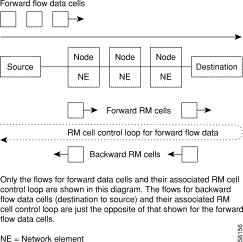
ForeSight may be used for congestion control across BPX/IGX switches for connections that have one or both end points terminating on ASI-T3/E3 or BXM cards. The ForeSight feature is a proprietary dynamic closed-loop, rate-based, congestion management feature that yields bandwidth savings compared to non-ForeSight equipped trunks when transmitting bursty data across cell-based networks. The BXM cards also support the VSVD congestion control mechanism as specified in the ATM Traffic Management 4.0 standards.
There are two connection addressing modes supported. The user may enter a unique VPI/VCI address in which case the BPX switch functions as a virtual circuit switch. Or the user may enter only a VPI address in which case all circuits are switched to the same destination port and the BPX switch functions as a virtual path switch in this case. The full ATM address range for VPI and VCI is supported.Virtual Path Connections are identified by an * in the VCI field. Virtual Circuit Connections specify both the VPI and VCI fields.
The VPI and VCI fields have significance only to the local BPX switch, and are translated by tables in the BPX switch to route the connection. Connections are automatically routed by the AutoRoute feature once the connection endpoints are specified.
ATM connections can be added using either the Cisco WAN Manager Connection Manager or a node's command line interface (CLI). Typically, the Cisco WAN Manager Connection Manager is the preferred method as it has an easy to use GUI interface. The CLI may be the method of choice in some special cases or during initial node setup for local nodes.
When adding ATM connections, first the access port and access service lines connecting to the customer CPE need to be configured. Also, the trunks across the network need to configured appropriately for the type of connection. Following that the addcon command may be used to add a connection, first specifying the service type and then the appropriate parameters for the connection.
For example, when configuring a BXM for CPE connections, the BXM is configured for port mode, a line is upped with the upln command and configured with the cnfln command. Then the associated port is configured with the cnfport command and upped with the upport command. Following this, the ATM connections are added via the addcon command with the syntax.
ATM connections for a BXM or ASI card are identified as follows:
The slot and port are related to the BPX switch hardware. Virtual path connections (VPCs) are identified by a "*" for the VCI field. Virtual circuit connections (VCCs) are identified by both a VPI and VCI field.
Connections added to the network are automatically routed once the end points are specified. This AutoRoute feature is standard with all BPX, IGX, and IPX switches. The network automatically detects trunk failures and routes connections around the failures.
The following parameters are entered for the BXM addcon command. Depending upon the connection type, the user is prompted for the appropriate parameters as shown in the following:
addcon local_addr node remote_addr traffic_type/class number....extended parameters
EXAMPLES
addcon 2.2.11.11 pubsbpx1 2.3.12.12 3
addcon 2.3.22.22 pubsbpx1 2.2.24.24 abrstd 50/50 100/100 50/50
25000/* e e e d 50/50 * 3 * 80/* 35/* 20/* 50/* * 100 128 16 32 0 *
| Field | Value | Description | |
|---|---|---|---|
| local/remote_addr | slot.port.vpi.vci | desired VCC or VPI connection identifier |
| node |
| slave end of connection |
| traffic_type/connection class |
| Type of traffic, chosen from service type (nrt/rt-VBR, CBR, UBR, ABRSTD, ABRFST, ATFR, ATFST, ATFT, ATFTFST, ATFX, ATFXFST) or connection class. For example, for rt-VBR, connection class 3 for a new node runing Rel. 9.2.20. Note For a new node running 9.2.20 or later, the rt-VBR connection class number is 3. An upgraded node wil retain existing connection classes. Therefore, it won't have the rt-VBR connection class 3. However, the user can configure the connection classes to whatever service and parameters they want using the cnfcls/cnfatmcls command. |
| extended parameters |
| Additional traffic management and performance parameters associated with some of the ATM connection types, for example ABRSTD with VSVD enabled and default extended parameters disabled. |
The following example shows the initial steps in adding a connection with the addcon command, and the addcon prompt requesting the user to enter the ATM type of service.
pubsbpx1 TN silves BPX 8620 9.2.2G July 21 1999 21:32 PDT
Local Remote Remote Route
Channel NodeName Channel State Type Avoid COS O
2.2.1.4 pubsbpx1 2.3.5.7 Ok nrt-vbr
2.2.1.5 pubsbpx1 2.3.5.8 Ok rt-vbr
2.2.1.6 pubsbpx1 2.3.5.9 Ok rt-vbr
2.3.5.7 pubsbpx1 2.2.1.4 Ok nrt-vbr
2.3.5.8 pubsbpx1 2.2.1.5 Ok rt-vbr
2.3.5.9 pubsbpx1 2.2.1.6 Ok rt-vbr
This Command: addcon 2.2.11.11 pubsbpx1 2.3.12.12
Enter (nrt/rt-VBR,CBR,UBR,ABRSTD,ABRFST,ATFR,ATFST,ATFT,ATFTFST,ATFX,ATFXFST)
or class number:
Instead of entering a class of service, the user can instead enter a class number to select a pre-configured template, for example, class 4 for NTR-VBR, and class 3 for RT-VBR. The class of service templates can be modified as required using the cnfcls/cnfatmcls command and displayed using the dspcls/dspatmcls command.
An example of a cnfcls/cnfatmcls command and response is shown in the following example:
pubsbpx1 TN silves:1 BPX 8620 9.2.2G July 16 1999 10:42 PDT
ATM Connection Classes
Class: 2 Type: nrt-VBR
PCR(0+1) % Util CDVT(0+1) AAL5 FBTC SCR
1000/1000 100/100 10000/10000 n 1000/1000
MBS Policing
1000/1000 3
Description: "Default nrt-VBR 1000 "
This Command: cnfcls atm 2
Enter class type (rt-VBR, nrt-VBR, CBR, UBR, ABRSTD, ABRFST, ATFR, ATFST, ATFT,
ATFTFST, ATFX, ATFXFST):
The BPX supports the standard ATM service types, CBR, rt-VBR, nrt-VBR, ABR, and UBR. When adding a connection, using the addcon command, these service types are selected by entering one of the CLI service type entries shown in Table 13-2 when prompted:
| CLI Service Type Entries | Connection Description |
CBR | cell bit rate |
rt-VBR | real time VBR |
nrt-VBR | non real time VBR |
UBR | unspecified bit rate |
ABRSTD | ABR per forum standard, with option to enable VSVD congestion control. |
ABRFST | ABR with Cisco ForeSight congestion control. |
The BPX also supports ATM to Frame Relay Network Interworking and Service Interworking connections. When adding a connection using the addcon command, these service types are selected by entering one of the CLI service type entries shown in Table 13-3 when prompted:
| CLI Service Type Entries for addcon command | Connection Description |
ATFR | ATM to Frame Relay Network Interworking |
ATFST | Same as ATFR with ForeSight |
ATFT | ATM to Frame Relay Transparent Service Interworking |
ATFTFST | Same as ATFT with ForeSight |
ATFX | ATM to Frame Relay Translational Service Interworking |
ATFXFST | Same as ATFX with ForeSight |
Advanced CoS management provides per-VC queueing and per-VC scheduling. CoS management provides fairness between connections and firewalls between connections. Firewalls prevent a single non-compliant connection from affecting the QoS of compliant connections. The non-compliant connection simply overflows its own buffer.
The cells received by a port are not automatically transmitted by that port out to the network trunks at the port access rate. Each VC is assigned its own ingress queue that buffers the connection at the entry to the network. With ABR with VSVD or with Optimized Bandwidth Management (ForeSight), the service rate can be adjusted up and down depending on network congestion.
Network queues buffer the data at the trunk interfaces throughout the network according to the connection's class of service. Service classes are defined by standards-based QoS. Classes can consist of the five service classes defined in the ATM standards as well as multiple sub-classes to each of these classes. Classes can range from constant bit rate services with minimal cell delay variation to variable bit rates with less stringent cell delay.
When cells are received from the network for transmission out a port, egress queues at that port provide additional buffering based on the service class of the connection.
CoS Management provides an effective means of managing the quality of service defined for various types of traffic. It permits network operators to segregate traffic to provide more control over the way that network capacity is divided among users. This is especially important when there are multiple user services on one network.
Rather than limiting the user to the five broad classes of service defined by the ATM standards committees, CoS management can provide up to 16 classes of service (service subclasses) that can be further defined by the user and assigned to connections. Some of the COS parameters that may be assigned include:
These class of service parameters are based on the standards-based Quality of Service parameters and are software programmable by the user. The BPX switch provides separate queues for each traffic class.
The example shown in Figure 13-3 shows the general ATM connection flow through BXM cards in BPX switches. The cnfport, cnfportq, cnfln, cnftrk, and cnftrkparm commands are used to configure resources affecting the traffic flow of a connection. Examples are described in Traffic Shaping for CBR, rt-VBR, nrt-VBR, and UBR.
ATM cells from CPE 1 that are applied to BXM 3, Figure 13-3, are processed at the physical level, policed per individual VC based on ATM header payload type, and routed to the applicable one of 15 per card slot servers, each of which contains 16 CoS service queues, including ATM service types CBR, rt-VBR, nrt-VBR, ABR, and UBR.
ATM cells undergoing traffic shaping, e.g., ABR cells, are applied to traffic shaping queues before going to one of the 15 per card slot servers. ATM cells applied to the traffic shaping queues receive additional processing, including congestion control by means of VSVD or ForeSight and virtual connection queuing.
Cells are served out from the slot servers via the BPX backplane to the BCC crosspoint switch. The cells are served out on a fair basis with priority based on class of service, time in queue, bandwidth requirements, etc.
In this example, ATM cells destined for BPX 2 are applied via the BCC crosspoint switch and BPX backplane to BXM 10 and out to the network. The cells are served out to the network via the appropriate trunk qbin, CBR, rt-VBR, nrt-VBR, ABR, or UBR.
ATM cells from the network that are applied to BXM 5 in BPX 2 are processed at the physical level and routed to one of 15 per card slot servers, each of which contains 16 CoS service queues, including ATM service types CBR, rt-VBR, nrt-VBR, ABR, and UBR.
Cells are served out from the slot servers via the BPX backplane to the BCC crosspoint switch. The cells are served out on a fair basis with priority based on class of service, time in queue, bandwidth requirements, etc.
In this example, ATM cells destined for CPE 2 are applied via the BCC crosspoint switch and BPX backplane to BXM 11 and out to CPE 2. The cells are served out to CPE 2 via the appropriate port qbin, CBR, rt-VBR, nrt-VBR, or ABR/UBR.
ATM cells undergoing traffic shaping, e.g., ABR cells, are applied to traffic shaping queues before going to one of the 15 per card slot servers. ATM cells applied to the traffic shaping queues receive additional processing, including congestion control by means of VSVD or ForeSight and virtual connection queuing.
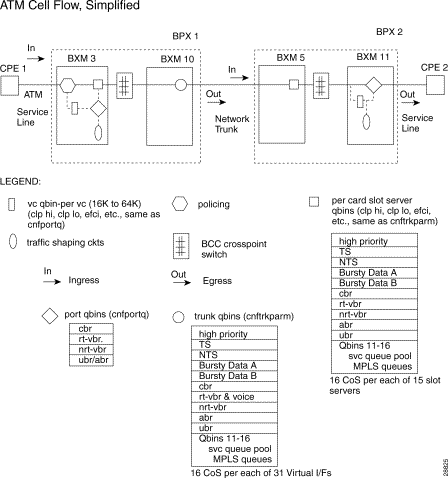
With the introduction of traffic shaping for CBR, VBR, and UBR, the user has the option to provide traffic shaping for these connections types on the BXM. Previously, only ABR utilized traffic shaping. Traffic shaping involves passing CBR, VBR, or UBR traffic streams through VC queues for scheduled rate shaping.
Traffic shaping is performed on a per port basis. When traffic shaping is enabled, all traffic exiting the port (out to the network) is subject to VC scheduling based on the parameters configured by the user for the connection.
Figure 13-4 shows an example of traffic shaping. In this example, port 1 is configured to perform traffic shaping. Note that all the ATM cells regardless of class of service pass through the VC queues before leaving the card when traffic shaping is enabled. In the example, port 2 is not configured for traffic shaping, and only the ABR traffic with FCES (flow control external segment) passes through the VC queues.

Traffic shaping rates are listed in Table 13-4.
| Service Type | MCR | PCR |
|---|---|---|
CBR | PCR | PCR |
rt-VBR and nrt-VBR | SCR * %Util | PCR |
UBR | 0 | PCR |
ABR | MCR * %Util | PCR |
Traffic shaping is disabled by default. The cnfport and cnfln command is used to enable and disable the function on a per port basis. The cnftrk command is used to enable traffic shaping on trunks.No connections should be enabled on the port prior to changing the port traffic shaping parameter. If there are existing connections when the port is toggled, then these connections will not be updated unless the card is reset, connections are rerouted, a switchcc occurs, or the user modifies the connection parameters. See the following examples of the cnfln, cnfport, and cnftrk commands:
Example of cnfln:
pubsbpx1 TN silves BPX 8620 9.2.2 Aug. 1 1999 14:41 PDT
LN 2.2 Config OC3 [353208cps] BXM slot: 2
Loop clock: No Idle code: 7F hex
Line framing: --
coding: --
CRC: --
recv impedance: --
E1 signalling: --
encoding: -- cable type: --
T1 signalling: -- length: --
HCS Masking: Yes
Payload Scramble: Yes
56KBS Bit Pos: -- Frame Scramble: Yes
pct fast modem: -- Cell Framing: STS-3C
VC Shaping: No
Last Command: cnfln 2.2
Next Command:
Example of cnfport:
pubsbpx1 TN silves BPX 8620 9.2.2 Aug. 1 1999 15:12 PDT
Port: 2.2 [ACTIVE ]
Interface: LM-BXM CAC Override: Enabled
Type: UNI %Util Use: Disabled
Shift: NO SHIFT (Virtual Trunk Operation)
SIG Queue Depth: 640 Port Load: 28 %
Protocol: NONE Protocol by Card: No
Last Command: cnfport 2.2
Next Command:
Example of cnftrk:
pubsbpx1 TN silves BPX 8620 9.2.2G Aug. 1 1999 14:43 PDT
TRK 2.4 Config OC3 [353207cps] BXM slot: 2
Transmit Rate: 353208 Line framing: STS-3C
Protocol By The Card: No coding: --
VC Shaping: No CRC: --
Hdr Type NNI: Yes recv impedance: --
Statistical Reserve: 1000 cps cable type: --
Idle code: 7F hex length: --
Connection Channels: 256 Pass sync: No
Traffic:V,TS,NTS,FR,FST,CBR,NRT-VBR,ABR, T-VBR clock: No
SVC Vpi Min: 0 HCS Masking: Yes
SVC Channels: 0 Payload Scramble: Yes
SVC Bandwidth: 0 cps Frame Scramble: Yes
Restrict CC traffic: No Virtual Trunk Type: --
Link type: Terrestrial Virtual Trunk VPI: --
Routing Cost: 10 Deroute delay time: 0 seconds
This Command: cnftrk 2.4
Transmit Rate [ 1-353208 ]:
With Rel. 9.2.20 and later, rt-VBR and nrt-VBR connections are specified separately when adding a connection using the addcon command by entering either rt-vbr or nrt-vbr to select the rt-VBR or nrt-VBR connection class, respectively. Each connection is assigned the applicable associated default parameters for its type of service.
For rt-VBR an additional queue, referred to as the rt-VBR queue, is used at a BXM or ASI port. At BXM or BNI trunks, voice and rt-VBR traffic share a queue, referred to as the rt-VBR queue.
The rt-VBR and nrt-VBR service queues are configured differently from each other at both port ingress and port egress queues. The rt-VBR typically uses smaller queues for low delay, whereas the nrt-VBR queues are typically larger in size for more efficient bandwidth sharing with other non-real time service types.
The rt-VBR connections are configured per class 3 service parameters, and nrt-VBR connections are configured per class 2 service parameters. These class parameters can be changed using the cnfcls/cnfatmcls command, or the parameters can be entered individually for each connection by specifying `yes' to the extended parameters prompt of the addcon command.
Examplef cnfcls 3, for rt-VBR
pubsbpx1 TN silves:1 BPX 8620 9.2.2G July 16 1999 10:42 PDT
ATM Connection Classes
Class: 3 Type: rt-VBR
PCR(0+1) % Util CDVT(0+1) AAL5 FBTC SCR
4000/4000 100/100 10000/10000 n 4000/4000
MBS Policing
1000/1000 3
Description: "Default rt-VBR 4000 "
This Command: cnfcls atm 3
Enter class type (rt-VBR, nrt-VBR, CBR, UBR, ABRSTD, ABRFST, ATFR, ATFST, ATFT,
ATFTFST, ATFX, ATFXFST):
Example of cnfcls2, for NRT-VBR
pubsbpx1 TN silves:1 BPX 8620 9.2.2G July 16 1999 10:42 PDT
ATM Connection Classes
Class: 2 Type: nrt-VBR
PCR(0+1) % Util CDVT(0+1) AAL5 FBTC SCR
1000/1000 100/100 10000/10000 n 1000/1000
MBS Policing
1000/1000 3
Description: "Default nrt-VBR 1000 "
This Command: cnfcls atm 2
Enter class type (rt-VBR, nrt-VBR, CBR, UBR, ABRSTD, ABRFST, ATFR, ATFST, ATFT,
ATFTFST, ATFX, ATFXFST):
The BPX Command Line Interface (CLI) and Cisco WAN Manager accept the same connection policing and bandwidth parameters as in previous releases for both rt-VBR and nrt-VBR service.
The displayed addcon parameter prompts for both rt-VBR and nrt-VBR connections are the same. These prompts are: PCR, %util, CDVT, FBTC flag, SCR, MBS, and Policing Type.
There is no change in CDVT usage and the previous policing system.
When using the addcon command without the extended parameters, rt-VBR connections, automatically use the parameters provided by connection class 3 which contains pre-determined values. Similarly, nrt-VBR connections use connection class 2. The values of a connection class can be modified by using the cnfcls/cnfatmcl command. These values are displayed by the dspcls/dspatmcls commands.
Qbin values on both ports and trunks used by rt-VBR connections and nrt-VBR connections can be configured separately.
A rt-VBR connection uses the rt-VBR queue on a trunk. It shares this queue with voice traffic. The rt-VBR and voice traffic shares the default or user configured parameters for the rt-VBR queue. These parameters are queue depth, queue CLP high and CLP low thresholds, EFCI threshold, and queue priority.
A nrt-VBR connection uses the nrt-VBR queue on a trunk. The configurable parameters are queue depth, queue CLP high and CLP low thresholds, EFCI threshold, and queue priority.
The following example shows the cnftrkparm screen and the parameters that can be configured for the various service type queues:
pubsbpx1 TN silves:1 BPX 8620 9.2.2G July 16 1999 10:50 PDT
TRK 2.4 Parameters
1 Q Depth - rt-VBR [ 885] (Dec) 15 Q Depth - CBR [ 600] (Dec)
2 Q Depth - Non-TS [ 1324] (Dec) 16 Q Depth - nrt-VBR [ 5000] (Dec)
3 Q Depth - TS [ 1000] (Dec) 17 Q Depth - ABR [20000] (Dec)
4 Q Depth - BData A [10000] (Dec) 18 Low CLP - CBR [ 60] (%)
5 Q Depth - BData B [10000] (Dec) 19 High CLP - CBR [ 80] (%)
6 Q Depth - High Pri [ 1000] (Dec) 20 Low CLP - nrt-VBR [ 60] (%)
7 Max Age - rt-VBR [ 20] (Dec) 21 High CLP - nrt-VBR [ 80] (%)
8 Red Alm - I/O (Dec) [ 2500 / 10000]22 Low CLP/EPD-ABR [ 60] (%)
9 Yel Alm - I/O (Dec) [ 2500 / 10000]23 High CLP - ABR [ 80] (%)
10 Low CLP - BData A [ 100] (%) 24 EFCN - ABR [ 20] (%)
11 High CLP - BData A [ 100] (%) 25 SVC Queue Pool Size [ 0] (Dec)
12 Low CLP - BData B [ 25] (%)
13 High CLP - BData B [ 75] (%)
14 EFCN - BData B [ 30] (Dec)
This Command: cnftrkparm 2.4
The rt-VBR and nrt-VBR connections use different queues on a port, these are the rt-VBR and nrt-VBR queues, respectively. A user can configure these separately, using the cnfportq command.
The following example shows he configuration parameters available for a port queue.
Port Queue Parameters, cnfportq
pubsbpx1 TN silves:1 BPX 8620 9.2.2G July 16 1999 10:47 PDT
Port: 2.2 [ACTIVE ]
Interface: LM-BXM
Type: UNI
Speed: 353208 (cps)
SVC Queue Pool Size: 0
CBR Queue Depth: 600 rt-VBR Queue Depth: 0
CBR Queue CLP High Threshold: 80% rt-VBR Queue CLP High Threshold: 80%
CBR Queue CLP Low Threshold: 60% rt-VBR Queue CLP Low/EPD Threshold: 60%
CBR Queue EFCI Threshold: 60% rt-VBR Queue EFCI Threshold: 80%
nrt-VBR Queue Depth: 5000 UBR/ABR Queue Depth: 20000
nrt-VBR Queue CLP High Threshold: 80% UBR/ABR Queue CLP High Threshold: 80%
nrt-VBR Queue CLP Low Threshold: 60% UBR/ABR Queue CLP Low/EPD Threshold:60%
nrt-VBR Queue EFCI Threshold: 60% UBR/ABR Queue EFCI Threshold: 20%
This Command: cnfportq 2.2
The following commands are related to the process of adding and monitoring ATM connections
addcon, dspload, cnfcls, cnfatmcls, cnfcls, cnfcon, cnftrkparms, dsptrkcnf, dspatmcls, dspcls, dsconcls, dspconcnf, dspcon, dspcons, dlcon, dcct, dvcparms, dvc, cnfpre, dsptrkcnf, dspload, chklm, dsplm, updates, upport, dspportq, cnfportq, dspblkfuncs, dspchstats, dspportstats, dsptrkstats, dsptrkerrs.
For additional information on CLI command usage, refer to the Release 9.2, Cisco WAN Switching Command Reference and Super User manuals.
The following figures and tables describe the parameters used to configure ATM connections:
The following figures list the connection parameters in the same sequence as they are entered when a connection is added:
The following figure shows the VSVD network segment and external segment options available when ABR Standard or ABR ForeSight is selected. ForeSight congestion control is useful when both ends of a connection do not terminate on BXM cards. At present, FCES (Flow Control External Segment) as shown in Figure 13-8 is not available for ABR with ForeSight.
The following figures list the connection parameters in the same sequence as they are entered when a connection is added:
| Connection Type | ATM Forum TM spec. 4.0 conformance definition | PCR Flow (1st leaky bucket) | CLP tagging (for PCR flow) | SCR Flow (2nd leaky bucket) | CLP tagging (for SCR flow) |
|---|---|---|---|---|---|
CBR | CBR.1 when policing set to 4 (PCR policing only) | CLP(0+1) | no | off | n/a |
CBR | when policing set to 5 (off) | off | n/a | off | n/a |
UBR | UBR.1 when CLP setting = no | CLP(0+1) | no | off | n/a |
UBR | UBR.2 when CLP setting = yes | CLP(0+1) | no | CLP(0) | yes |
rt/nrt-VBR, ABR, ATFR, ATFST | VBR.1 when policing set to 1 | CLP(0+1) | no | CLP(0+1) | no |
rt/nrt-VBR, ABR, ATFR, ATFST | VBR.2 when policing set to 2 | CLP(0+1) | no | CLP(0) | no |
rt/nrt-VBR, ABR, ATFR, ATFST | VBR.3 when policing set to 3 | CLP(0+1) | no | CLP(0) | yes |
rt/nrt-VBR, ABR, ATFR, ATFST | when policing set to 4 | CLP(0+1) | no | off | n/a |
rt/nrt-VBR, ABR, ATFR, ATFST | when policing set to 5 (off) | off | n/a | off | n/a |
Note 1: - For UBR.2, SCR = 0
Note 2:
| PARAMETER WITH [DEFAULT SETTING] | BXM T3/E3, OC3 & OC12 RANGE | ASI T3/E3 RANGE | ASI-155 RANGE |
|---|---|---|---|
50- T3/E3 cells/sec 50 - OC3 50 - OC12 | T3: MCR - 96000 E3: MCR - 80000 Limited to MCR - | OC3 (STM1): 0 - 353200
| |
%Util [100/100] for UBR [1/1] | 0 - 100% | 1 - 100% | 1 - 100% |
cells/sec 6 - T3/E3OC3/0C12 | T3: 0 - 96000 cells/sec E3: 0 - 80000 cells/sec | N/A | |
FBTC (AAL5 Frame Base Traffic Control): for rt/nrt-VBR [disable] for ABR/UBR [enable] for Path connection [disable] | enable/disable Note With the BXM, FBTC means packet discard on queueing only. | enable/disable Note With the ASI, FBTC means packet discard on both policing and queueing. | enable/disable Note With the ASI, FBTC means packet discard on both policing and queueing.
|
|
for CBR [10000/10000], others [250000/250000] | 0 - 5,000,000 usec | T3/E3 1 - 250,000 usecs.
| OC3/STM1: 0 - 10000 usecs. |
enable/disable | enable/disable | Select disable, as only ABR w/o VSVD is supported. | |
FCES (Flow Control External Segment) [disable] | enable/disable | enable/disable | N/A |
Default Extended Parameters[enable] | enable/disable | enable/disable | N/A |
enable/disable | enable/disable | enable/disable | |
cells/sec 50 - T3/E3OC3/OC12 | T3: MCR - 96000:T3 E3: MCR - 80000: E3
Limited to MCR - 5333 cells/sec for ATFR connections. | OC3/STM1: 0 - 353200 | |
1 - 5,000,000cells | T3/E3: 10 - 24000 cells
| OC3 (STM1): 10 - 1000 cells | |
|
For CBR: [4] | 1 - VBR.1 2 - VBR.2 3 - VBR.3 4 - PCR policing only 5 - off | 1 - VBR.1 2 - VBR.2 3 - VBR.3 4 - PCR policing only 5 - off | 1 - VBR.1 2 - VBR.2 3 - VBR.3 4 - PCR policing only 5 - off
|
|
max[MCR, PCR/10] | MCR - PCR cells/sec | MCR - PCR cells/sec | N/A |
62 - 8000 msec | 1000 - 255000 msecs. | N/A | |
ABRSTD: 1 - 100 msec ABRFST: 3 - 255 msec | 20 - 250 msecs. | N/A | |
|
For ATFR/ATFST [1366/1366] | 0 - 61440 cells | Applies to T3/E3 only | ATFR: 1 - 1366 cells |
1 - 100% | 1 - 100% | N/A | |
1 - 100% | 1 - 100% | N/A | |
|
For ATFR/ATFST [100/100] | 1 - 100% | 1 - 100% | 0 - 100% |
|
For ForeSight: max[PCR/128, 10]
For ABR STD[128] |
If ForeSight, then in absolute (0 - PCR)
If ABR then 2n (1 - 32768) |
If ForeSight, then in absolute (0 - PCR)
If ABR, then 2n (1 - 32768) | N/A |
|
For ForeSight [93]
For ABR STD [16] |
If ForeSight, then % (0% - 100%)
If ABR then 2n (1 - 32768) |
If ForeSight, then % (0% - 100%)
If ABR, then 2n (1 - 32768) | N/A |
2 - 256 cells | N/A | N/A | |
0 - 16700 msec | N/A | N/A | |
0 - 1,048,320 cells (different max range from TM spec. but limited by firmware for CRM(4095 only) where CRM=TBE/Nrm | N/A | N/A | |
0 - 24000 cells | T3/E3 ABR: 0 - 24000 cells ATFR: 1 - 107 cells | 0 - 999 cells | |
Trunk cell routing restrict (Y/N) [Y] | Y/N | Y/N | Y/N |
| Parameter | Description |
|---|---|
PCR | Peak cell rate: The cell rate which the source may never exceed |
%Util | % Utilization; bandwidth allocation for: rt/nrt-VBR, CBR, UBR it's PCR*%Util, for ABR it's MCR*%Util |
MCR | Minimum Cell Rate: A minimum cell rate committed for delivery by network |
CDVT | Cell Delay Variation Tolerance: Controls time scale over which the PCR is policed |
FBTC (AAL5 Frame Basic Traffic Control) | To enable the possibility of discarding the whole frame, not just one non-compliant cell. This is used to set the Early Packet Discard bit at every node along a connection. Note With the ASI, FBTC means packet discard on both policing and queueing. With the BXM, FBTC means packet discard on queueing only. |
VSVD | Virtual Source Virtual Destination: (see Meaning of VSVD and Flow Control External Segments, Figure 13-8) |
FCES (Flow Control External Segments) | (see Meaning of VSVD and Flow Control External Segments, Figure 13-8) |
SCR | Sustainable Cell Rate: Long term limit on the rate a connection can sustain |
MBS | Maximum Burst Size: Maximum number of cells which may burst at the PCR but still be compliant. Used to determine the Burst Tolerance (BT) which controls the time scale over which the SCR is policed |
Policing | (see definitions of Traffic Policing, Table 13-5) |
VC QDepth | VC Queue Depth |
CLP Hi | Cell Loss Priority Hi threshold (% of VC QMax) |
CLP Lo/EPD | Cell Loss Priority Low threshold (% of VC QMax)/Early Packet Discard. If AAL5 FBTC = yes, then for the BXM card this is the EPD threshold setting. For ASI cards, regardless of the FBTC setting, this is the CLP Lo setting. |
EFCI | Explicit Forward Congestion Indication threshold (% of VC QMax) |
ICR | Initial Cell Rate: The rate at which a source should send initially and after an idle period |
ADTF (ATM Forum TM 4.0 term) | The Allowed-Cell-Rate Decrease Factor: Time permitted between sending RM-cells before the rate is decreased to ICR |
Trm (ATM Forum TM 4.0 term) | An upper bound on the time between forward RM-cells for an active source, i.e., RM cell must be sent at least every Trm msec |
RIF (ATM Forum TM 4.0 term) | Rate Increase Factor: Controls the amount by which the cell transmission rate may increase upon receipt of an RM cell |
RDF (ATM Forum TM 4.0 term) | Rate Decrease Factor: Controls the amount by which the cell transmission rate may decrease upon receipt of an RM cell |
Nrm (ATM Forum TM 4.0 term), BXM only. | Nrm Maximum number of cells a source may send for each forward RM cell, i.e. an RM cell must be sent for every Nrm-1 data cells |
FRTT (ATM Forum TM 4.0 term), BXM only. | Fixed Round Trip Time: the sum of the fixed and propagation delays from the source to a destination and back |
TBE (ATM Forum TM 4.0 term), BXM only. | Transient Buffer Exposure: The negotiated number of cells that the network would like to limit the source to sending during start-up periods, before the first RM-cell returns. |
IBS | Initial Burst Size |
Trunk cell routing restriction (Y/N) [Y] | The default (Y) restricts ATM connection routes to include only ATM trunks. Selecting (N) allows the network to route these connections over non-ATM trunks (e.g., Fastpacket trunks). |
The CBR (constant bit rate) category is a fixed bandwidth class. CBR traffic is more time dependent, less tolerant of delay, and generally more deterministic in bandwidth requirements. CBR is used by connections that require a specific amount of bandwidth to be available continuously throughout the duration of a connection. Voice, circuit emulation, and high-resolution video are typical examples of traffic utilizing this type of connection. A CBR connection is allowed to transmit cells at the peak rate, below the peak rate, or not at all. CBR is characterized by peak cell rate (PCR).
The parameters for a CBR connection are shown in Figure 13-5 in the sequence in which they occur during the execution of the addcon command. The CBR policing definitions are summarized in Table 13-8.
| Connection Type | ATM Forum TM spec. 4.0 conformance definition | PCR Flow (1st leaky bucket) | CLP tagging (for PCR flow) | SCR Flow (2nd leaky bucket) | CLP tagging (for SCR flow) |
|---|---|---|---|---|---|
CBR | CBR.1 when policing set to 4 (PCR Policing only) | CLP(0+1) | no | off | n/a |
CBR | When policing set to 5 (off) | off | n/a | off | n/a |
VBR (variable bit rate) connections may be classified as rt-VBR or nrt-VBR connections.
The rt-VBR (real-time variable bit rate) category is used for connections that transmit at a rate varying with time and that can be described as bursty, often requiring large amounts of bandwidth when active. The rt-VBR class is intended for applications that require tightly constrained delay and delay variation such as compressed voice video conferencing. For example, video conferencing which requires real-time data transfer with bandwidth requirements that can vary in proportion to the dynamics of the video image at any given time. The rt-VBR category is characterized in terms of PCR, SCR (sustained cell rate), and MBS (maximum burst size).
The nrt-VBR (non-real time variable bit rate) category is used for connections that are bursty but are not constrained by delay and delay variation boundaries. For those cells in compliance with the traffic contract, a low cell loss is expected. Non-time critical data file transfers are an example of an nrt-VBR connection. A nrt-VBR connection is characterized by PCR, SCR, and MBS.
Configuring VBR connections. The characteristics of rt-VBR or nrt-VBR are supported by appropriately configuring the parameters of the VBR connection.
The parameters for a VBR connection are shown in Figure 13-6 in the sequence in which they occur during the execution of the addcon command. The VBR policing definitions are summarized in Table 13-9.
| Connection Type | ATM Forum TM spec. 4.0 conformance definition | PCR Flow (1st leaky bucket) | CLP tagging (for PCR flow) | SCR Flow (2nd leaky bucket) | CLP tagging (for SCR flow) |
|---|---|---|---|---|---|
rt/nrt-VBR, ABR, ATFR, ATFST, ATFT, ATFTST, ATFX, ATFXFST | VBR.1 when policing set to 1 | CLP(0+1) | no | CLP(0+1) | no |
rt/nrt-VBR, ABR, ATFR, ATFST, ATFT, ATFTST, ATFX, ATFXFST | VBR.2 when policing set to 2 | CLP(0+1) | no | CLP(0) | no |
rt/nrt-VBR, ABR, ATFR, ATFST, ATFT, ATFTST, ATFX, ATFXFST | VBR.3 when policing set to 3 | CLP(0+1) | no | CLP(0) | yes |
rt/nrt-VBR, ABR, ATFR, ATFST, ATFT, ATFTST, ATFX, ATFXFST | when policing set to 4 | CLP(0+1) | no | off | n/a |
rt/nrt-VBR, ABR, ATFR, ATFS, ATFT, ATFTST, ATFX, ATFXFST | when policing set to 5 for off | off | n/a | off | n/a |
The term ABR is used to specify one of the following:
The ABR (available bit rate) category utilizes a congestion flow control mechanism to control congestion during busy periods and to take advantage of available bandwidth during less busy periods. The congestion flow control mechanism provides feedback to control the connections flow rate through the network in response to network bandwidth availability. The ABR service is not restricted by bounding delay or delay variation and is not intended to support real-time connections. ABR is characterized by: PCR and MCR.
Policing for ABR connections is the same as for VBR connections which are summarized in Table 13-9.
The ABR connections are configured as either ABR Standard (ABRSTD) connections or as ABR ForeSight (ABRFST) connections.
The parameters for an ABRSTD connection are shown in Figure 13-7 in the sequence in which they occur during the execution of the addcon command.
The ABRSTD connection supports all the features of ATM Standards Traffic Management 4.0 including VSVD congestion flow control.
VSVD and flow control with external segments are shown in Figure 13-8.
The ABRSTD connection uses VSVD congestion control.
The parameters for an ABRSTD connection are shown in Figure 13-9 in the sequence in which they occur during the execution of the addcon command
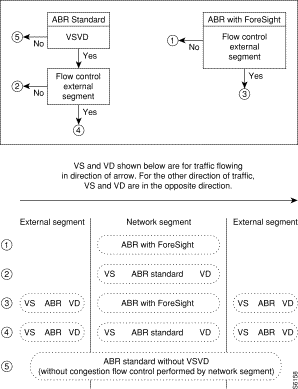
The ABRFST connection uses the propriety ForeSight congestion control and is useful when configuring connections on which both ends do not terminate on BXM cards.
The parameters for an ABRFST connection are shown in Figure 13-9 in the sequence in which they occur during the execution of the addcon command.
The unspecified bit rate (UBR) connection service is similar to the ABR connection service for bursty data. However, UBR traffic is delivered only when there is spare bandwidth in the network. This is enforced by setting the CLP bit on UBR traffic when it enters a port.
Therefore, traffic is served out to the network only when no other traffic is waiting to be served first. The UBR traffic does not affect the trunk loading calculations performed by the switch software.
The parameters for a UBR connection are shown in Figure 13-10 in the sequence in which they occur during the execution of the addcon command.
The UBR policing definitions are summarized in Table 13-10.
| Connection Type | ATM Forum TM spec. 4.0 conformance definition | PCR Flow (1st leaky bucket) | CLP tagging (for PCR flow) | SCR Flow (2nd leaky bucket) | CLP tagging (for SCR flow) |
|---|---|---|---|---|---|
UBR | UBR.1 when CLP setting = no | CLP(0+1) | no | off | n/a |
UBR | UBR.2 when CLP setting = yes | CLP(0+1) | no | CLP(0) | yes |
Frame Relay to ATM Interworking enables Frame Relay traffic to be connected across high-speed ATM trunks using ATM standard Network and Service Interworking (see Figure 13-11 and Figure 13-12).
Two types of Frame Relay to ATM interworking are supported, Network Interworking and Service Interworking. The Network Interworking function is performed by the BTM card on the IGX switch. The FRSM card on the MGX 8220 supports both Network and Service Interworking.
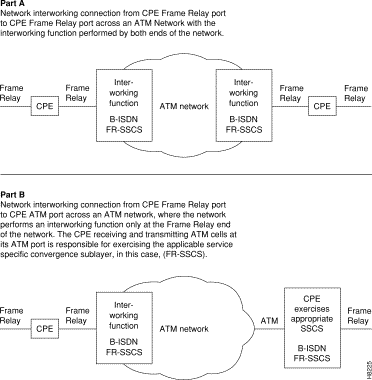

An ATFR (ATM to Frame Relay) connection is a Frame Relay to ATM connection and is configured as a VBR connection, with a number of the ATM and Frame Relay connection parameters being mapped between each side of the connection.
The parameters for an ATFR connection are shown in Figure 13-13 in the sequence in which they occur during the execution of the addcon command.
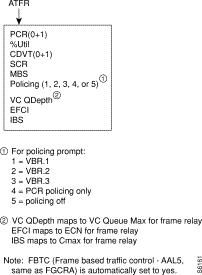
An ATFST connection is a Frame Relay to ATM connection that is configured as an ABR connection with ForeSight. ForeSight congestion control is automatically enabled when connection type ATFST is selected. A number of the ATM and Frame Relay connection parameters are mapped between each side of the connection.
The parameters for an ATFST connection are shown in Figure 13-14 in the sequence in which they occur during the execution of the addcon command.
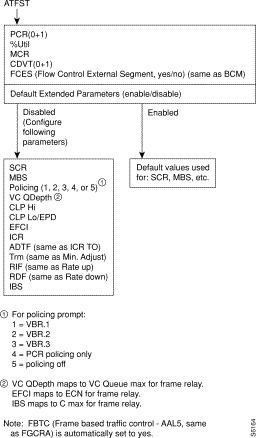
An ATFT connection is a Frame Relay to ATM transparent Service Interworking connection and is configured as a VBR connection, with a number of the ATM and Frame Relay connection parameters being mapped between each side of the connection..
The parameters for an ATFT connection are shown in Figure 13-15 in the sequence in which they occur during the execution of the addcon command.
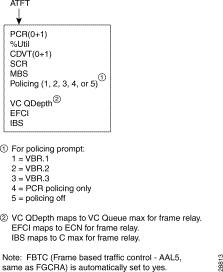
An ATFTFST connection is a Frame Relay to ATM transparent Service Interworking connection that is configured as an ABR connection with ForeSight. ForeSight congestion control is automatically enabled when connection type ATFTFST is selected. A number of the ATM and Frame Relay connection parameters are mapped between each side of the connection.
The parameters for an ATFTFST connection are shown in Figure 13-16 in the sequence in which they occur during the execution of the addcon command.
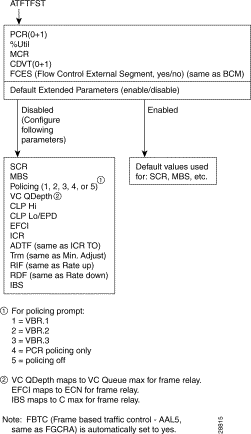
An ATFX connection is a Frame Relay to ATM translational Service Interworking connection and is configured as a VBR connection, with a number of the ATM and Frame Relay connection parameters being mapped between each side of the connection..
The parameters for an ATFX connection are shown in Figure 13-17 in the sequence in which they occur during the execution of the addcon command.
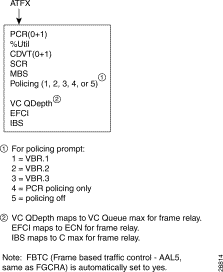
An ATFXFST connection is a Frame Relay to ATM translational Service Interworking connection that is configured as an ABR connection with ForeSight. ForeSight congestion control is automatically enabled when connection type ATFXFST is selected. A number of the ATM and Frame Relay connection parameters are mapped between each side of the connection.
The parameters for an ATFXFST connection are shown in Figure 13-18 in the sequence in which they occur during the execution of the addcon command.
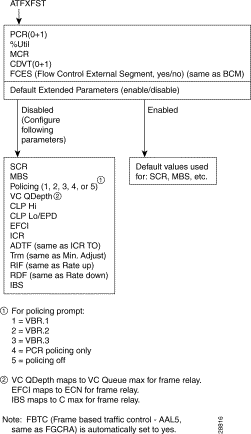
Traffic Policing, also known as Usage Parameter Control (UPC), is implemented using either an ATM Forum single or dual-leaky bucket algorithm. The buckets represent a GCRA (Generic Cell Rate Algorithm) defined by two parameters:
If the cells are clumped too closely together, they are non-compliant and are tagged or discarded as applicable. If other cells arrive on time or after their expected arrival time, they are compliant, but three is no accrued credit.
A GCRA viewpoint is as follows:
CBR traffic is expected to be at a constant bit rate, have low jitter, and is configured for a constant rate equal to Peak Cell Rate (PCR). The connection is expected to be always at peak rate.
When a connection is added, a VPI.VCI address is assigned, and the UPC parameters are configured for the connection. For each cell in an ATM stream seeking admission to the network, the VPI.VCI addresses are verified and each cell is checked for compliance with the UPC parameters. The CBR cells are not enqueued, but are processed by the policing function and then sent to the network unless discarded.
For CBR, traffic policing is based on:
The CBR connection may be configured with policing selected as either 4 or 5. With policing set to 5, there is no policing. With policing set to 4, there is single leaky bucket PCR policing as shown in Figure 13-19. The single leaky bucket polices the PCR compliance of all cells seeking admission to the network, both those with CLP = 0 and those with CLP =1. Cells seeking admission to the network with CLP set equal to 1 may have either encountered congestion along the user's network or may have lower importance to the user and have been designated as eligible for discard in the case congestion is encountered. If the bucket depth CDVT (0+1) limit is exceeded, it discards all cells seeking admission. It does not tag cells. If leaky bucket 1 is not full, all cells (CLP =0 and CLP=1) are admitted to the network.

Figure 13-20 shows a CBR.1 connection policing example, with policing set to 4, where the CDVT depth of the single leaky bucket is not exceeded, and all cells, CLP(0) and CLP(1) are admitted to the network.
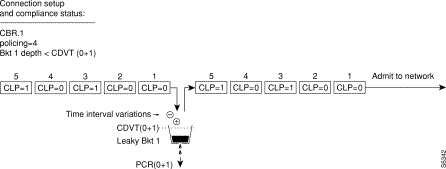
Figure 13-21 shows a CBR connection policing example, with policing =4, where the CDVT(0+1) of the single leaky bucket is exceeded and non-compliant cells are discarded. The leaky bucket only discards cells; it does not tag them
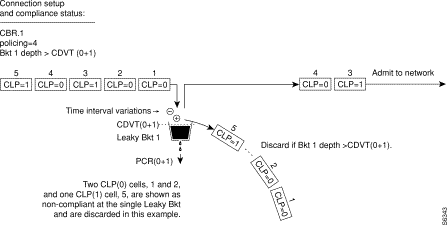
The contract for a variable bit rate connection is set up based on an agreed upon sustained cell rate (SCR) with allowance for occasional data bursts at a Peak Cell Rate (PCR) as specified by maximum burst size MBS.
When a connection is added, a VPI.VCI address is assigned, and UPC parameters are configured for the connection. For each cell in an ATM stream, the VPI.VCI addresses are verified and each cell is checked for compliance with the UPC parameters as shown in Figure 13-22.
The VBR cells are not enqueued, but are processed by the policing function and then sent to the network unless discarded.
For VBR, traffic policing, depending on selected policing option, is based on:
The policing options, selected by entering 1-5 in response to the policing choice prompt, are as follows for VBR connections:
VBR.1 VBR with policing set to 1. | CLP(0+1) cells compliant with leaky bucket 1 are passed to leaky bucket 2; non-compliant cells are discarded. CLP(0+1) cells compliant with leaky bucket 2 are admitted to the network; non-compliant cells are discarded. |
VBR.2 VBR with policing set to 2. | CLP(1) cells compliant with leaky bucket 1 are admitted to the network; non-compliant CLP(0+1) cells are dropped. CLP(0) cells compliant with leaky bucket 1 are applied to leaky bucket 2; non-compliant cells are dropped. CLP(0) cells compliant with leaky bucket 2 are admitted to the network; non-compliant cells are dropped. |
VBR.3 VBR with policing set to 3.
| CLP(1) cells compliant with leaky bucket 1 are admitted to the network; non-compliant CLP(0+1) cells are dropped. CLP(0) cells compliant with leaky bucket 1 are applied to leaky bucket 2; non-compliant cells are dropped. CLP(0) cells compliant with leaky bucket 2 are admitted to the network; non-compliant cells are tagged and admitted to the network. |
VBR with policing set to 4. | CLP(0+1) cells compliant with leaky bucket 1 are admitted to the network; non-compliant cells are dropped. Leaky bucket 2 is not active. |
VBR with policing set to 5. | Policing is off, so there is no policing of cells on ingress. |
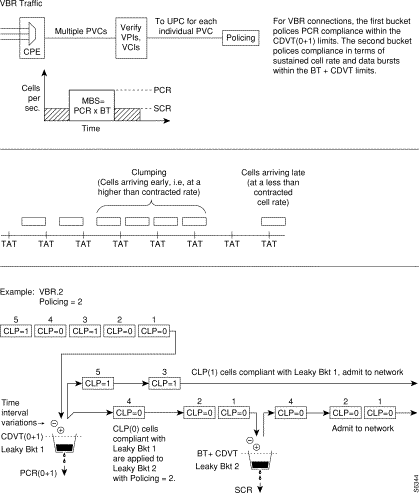
Leaky bucket 1 polices for the PCR compliance of all cells seeking admission to the network, both those with CLP = 0 and those with CLP =1. For example, cells seeking admission to the network with CLP set equal to 1 may have either encountered congestion along the user's network or may have lower importance to the user and have been designated as eligible for discard in the case congestion is encountered. If the bucket depth in the first bucket exceeds CDVT (0+1), it discards all cells seeking admission. It does not tag cells.
With policing set to 1 (VBR.1), all cells (CLP=0 and CLP=1) that are compliant with leaky bucket 1, are sent to leaky bucket 2. With policing set to 2 (VBR.2) or to 3 (VBR.3), all CLP=1 cells compliant with leaky bucket 1 are admitted directly to the network, and all CLP=0 cells compliant with leaky bucket 1 are sent to leaky bucket 2.
For VBR connections, the purpose of leaky bucket 2 is to police the cells passed from leaky bucket 1 for conformance with maximum burst size MBS as specified by BT and for compliance with the SCR sustained cell rate. The types of cells passed to leaky bucket 2 depend on how policing is set:
Figure 13-23 shows a VBR connection policing example, with policing set to 4, leaky bucket 1 compliant, and all cells being admitted to the network.
.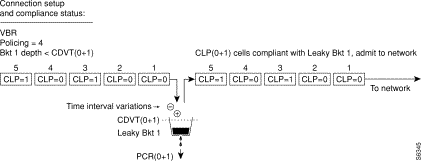
Figure 13-24 shows a VBR connection policing example, with the policing set to 4, and leaky bucket 1 non-compliant which indicates that the connection has exceeded the PCR for a long enough interval to exceed the CDVT (0+1) limit. Non-compliant cells with respect to leaky bucket 1 are discarded.
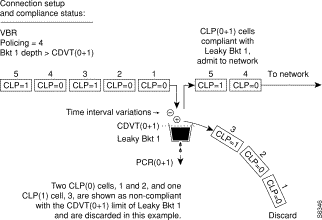
Figure 13-25 shows a VBR.2 connection policing example, with policing = 2, and both buckets compliant. Leaky bucket two is policing the CLP(0) cell stream for conformance with maximum burst size MBS (as specified by BT), and for compliance with the SCR sustained cell rate.

Figure 13-26 shows a VBR.2 connection policing example, with policing set to 2, and leaky bucket 2 non-compliant. Leaky bucket 2 is shown policing the CLP(0) cell stream for conformance with maximum burst size MBS (as specified by BT), and for compliance with SCR (sustained cell rate). In this example (policing set to 2), CLP tagging is not enabled, so the cells that have exceeded the BT + CDVT limit are discarded. In the example, either the sustained cell rate could have been exceeded for an excessive interval, or a data burst could have exceeded the maximum allowed burst size.
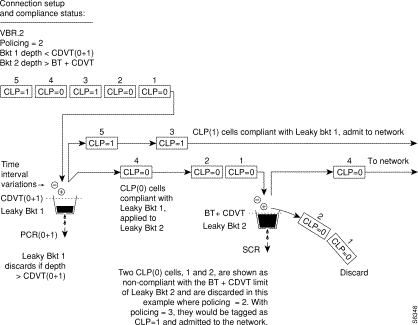
Figure 13-27 shows a VBR.1 connection policing example, with policing set to 1, and both buckets compliant. Leaky bucket 1 is policing the CLP (0+1) cell stream for conformance with the PCR limit. Leaky bucket 2 is policing the CLP (0+1) cell stream for conformance with CDVT plus maximum burst size MBS (as specified by BT), and for compliance with SCR sustained cell rate.
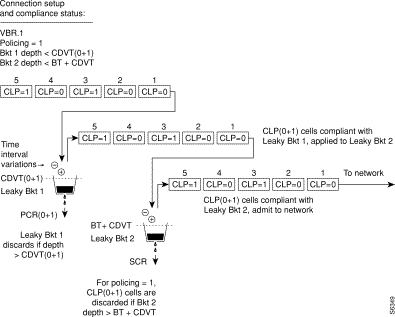
Figure 13-28 shows a VBR.3 connection policing example, with policing set to 3, and Leaky bucket 2 shown as non-compliant. Leaky bucket 2 is shown policing the CLP(0) cell stream for conformance with maximum burst size MBS (as specified by BT), and for compliance with SCR sustained cell rate. For the policing = 3 selection, CLP tagging is enabled, so the cells that have exceeded the BT + CDVT(0+1) limit are tagged as CLP=1 cells and admitted to the network. In this example, either the sustained cell rate could have been exceeded for an excessive interval, or a data burst could have exceeded the maximum burst size allowed.

Available Bit Rate (ABR) connections are policed the same as the VBR connections, but in addition use either the ABR Standard with VSVD congestion flow control method or the ForeSight option to take advantage of unused bandwidth when it is available.
The contract for a unspecified bit rate connection is similar to the ABR connection service for bursty data. However, UBR traffic is delivered only when there is spare bandwidth in the network.
When a connection is added, a VPI.VCI address is assigned, and UPC parameters are configured for the connection. For each cell in an ATM stream, the VPI.VCI addresses are verified and each cell is checked for compliance with the UPC parameters as shown in Figure 13-29.
Leaky bucket 1 polices the UBR connection for PCR compliance. When CLP=No (UBR.1), all cells that are compliant with leaky bucket 1 are applied to the network. However, these cells are treated with low priority in the network with % utilization default of 1%.
When CLP=Yes (UBR.2), CLP(0) cells that are compliant with leaky bucket 1 are sent to leaky bucket 2. Since SCR=0 for leaky bucket 2, the bucket is essentially always full, and all the CLP(0) cells sent to leaky bucket 2 are therefore tagged with CLP being set to 1. This allows the network to recognize these UBR cells as lower priority cells and available for discard in the event of network congestion.
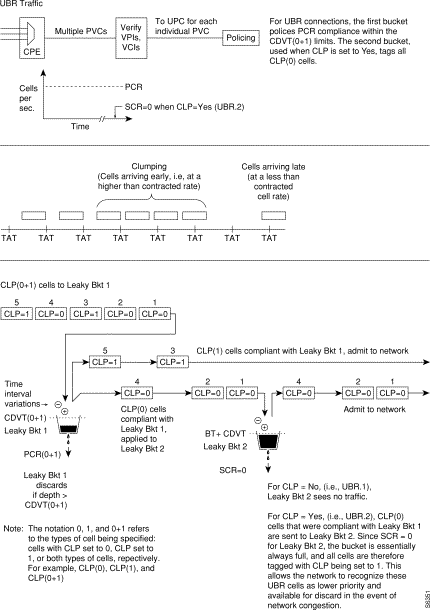
The following is a listing of the LMI and ILMI parameters for the ASI and BXM:
For ILMI information, refer to Table 13-11
| Parameter | Description |
|---|---|
VPI.VCI | VCCI for ILMI signaling channel equal 0.16 |
Polling Enabled | Keep-alive polling |
Trap Enabled | VCC change of state traps |
Polling Interval | Time between GetRequest polls |
Error Threshold | Number of failed entries before ILMI link failure is declared. |
Event Threshold | Number of successful polls before ILMI link failure is cancelled. |
Addr Reg Enab | SVC Address Registration procedures enabled. |
For the LMI information, refer to Table 13-11.
| Parameter | Description |
|---|---|
VPI.VCI | VCCI for LMI signaling channel equal 0.31 |
Polling Enable | Keep-alive polling |
T393 | Status Enquiry timeout value |
T394 | Update Status timeout value |
T396 | Status Enquiry polling timer |
N394 | Status Enquiry retry count |
N395 | Update Status retry count |
LMI and ILMI functions for the BXM card are moved to the card from the BCC to localize these functions. These functions support virtual UNIs and trunk ports - a total of 256 sessions on different interfaces (ports, trunks, virtual UNIs) per BXM.
The time to reroute connections varies depending on different parameters, such as the number of connections to reroute, reroute bundle size, etc. It is important to notify the CPE if a connection is derouted and fails to transport user data after a specified time interval. However, it is also desirable not to send out Abit = 0, then Abit =1 when a connection is derouted and rerouted quickly. Such notifictions may prematurely trigger the CPE backup facilities causing instabilities in an otherwise stable system.
The early Abit Notification with configurable timer feature provides a way to send Abit = 0 status changes over the LMI interface or to send ILMI traps over the ILMI interface after connections are derouted a certain amount of time. The time period is configurable. The configurable time allows the user the flexibility to synchronize the operation of the primary network and backup utilities, such as dialed backup over the ISDN or PSTN network. The feature can be turned on using the cnfnodeparm command. For further information, refer to the Rel. 9.2.20 Cisco WAN Switching Command Reference.
![]()
![]()
![]()
![]()
![]()
![]()
![]()
![]()
Posted: Thu Jul 26 18:03:23 PDT 2001
All contents are Copyright © 1992--2001 Cisco Systems, Inc. All rights reserved.
Important Notices and Privacy Statement.